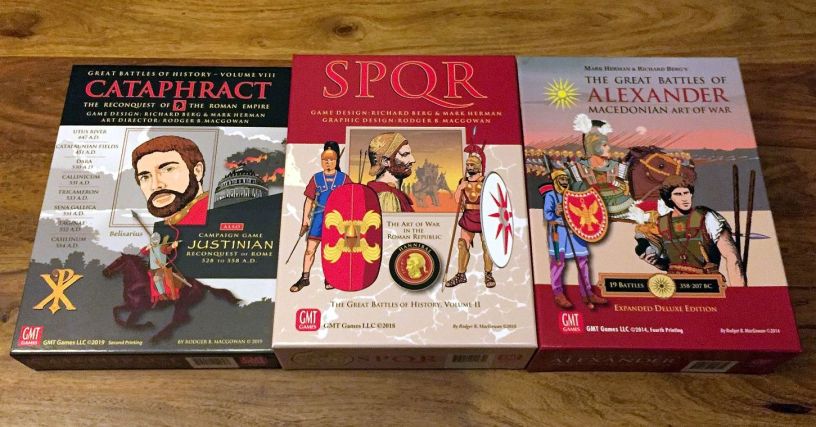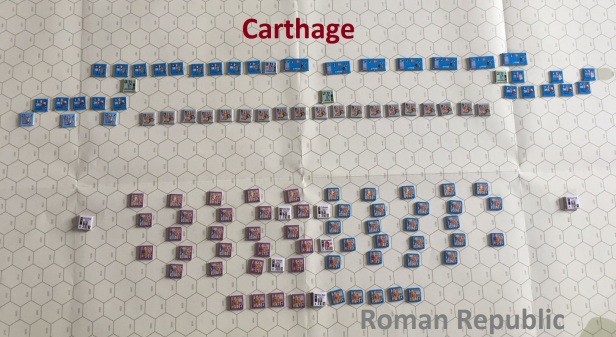Welcome again to the series of articles where I describe my favorite titles in various categories. Today’s episode will be special one. I will focus again (like in the case of Commands & Colors) on one system which spanned multiple volumes and is one of the most popular wargame productions of all times.
Other articles in the series:
What that would be? The Great Battles of History! A series of wargames designed by Mark Herman and Richard Berg, and published by GMT Games. These are the tactical level titles, with units representing hundreds of men and turns equivalent to about twenty minutes. Scenarios cover battles from Sumer (ca 2320 BC) to Thirty Years War battles in Europe, Africa, the Middle east and Japan. You can see all of them with one glimpse on the GMT Web Page.
While the system is pretty popular and widespread, I would like to briefly summarize its general concepts:
- hex & counter design
- detailed rules specifying, move, reactions of units, combat, morale, etc.
- different types of infantry units like skirmisher, light, medium, barbarian, heavy as well as of cavalry – light, heavy, cataphracts, elephants, camels, etc.
- variable initiative in the game, depending on the leaders characteristics
- victory by depleting opponent cohesion and routing units rather then destroying them
In below article I am presenting the three titles – out of XVI volumes and multiple expansions / add-ons – which for me personally are the greatest fun to play. Exactly – the fun factor was a decisive feature, enabling the particular game to enter the list. So, without further ado, let us move to the main text!
Cataphract (vol. VIII)
The Cataphract volume portrays the development of the art of war started by the early Byzantine Empire, during the reign of Emperor Justinian, under his great Generals, Belisarius and Narses. During this period the Byzantine Empire, for a brief period of time, re-captured a large portion of what was formerly the Western Roman Empire. Although successful in its attempts to reconquer Italy and North Africa, the Byzantine Empire’s resources were insufficient to hold on to its gains.
Cataphract covers all the major battles that defined this era. To place these battles in their proper historical context, the Campaign Game, Justinian, is enclosed, which covers the quest to reconquer the Roman Empire under one ruler.
That is definitely my favorite volume in the whole series. First, I am fan of ancient and early medieval history and the exploits of Belisarius and other Byzantyne generals simply hits the sweet spot nicely. Secondly, the average size of the scenarios in this volume is considerably small, which makes them perfect for one-session games, without need to stop in the middle or leave the map on the table till the next opportunity.
What is more, Cataphract features various nationalities in one small, box, ranging from Romans, to Sassanids Visigoths, Huns, Franks and other enemies of Byzantine. Last but not least, the recent edition is actually two games in a price of one – we have also Justinian mini-game, presenting on more strategic level the re-conquest of the Roman empire by that famous emperor.
If you add all those characteristics, you are getting very interesting, action-packed and diversified volume, great for the newcomers to the series (relatively small scenarios) but also giving so much tactical depth to be explored by the experienced players. Highly recommended!
More about game:
- BGG page
- [UNBOXING] Cataphract
- Some of the session reports:
SPQR (vol. II)

The first module in the series was about Macedonians. The second – pretty obvious choice – was about Romans! Mt Berg & Herman decided this time to focus on the Republican Army and its success – but also defeats – in the time when the groundwork for Roman Empire was being laid.
SPQR (Deluxe Edition) contains the five scenarios, maps and counters from the original SPQR, plus nine additional scenarios (and the requisite maps and counters) taken from various expansion modules – like Pyrrhic Victory, Africanus, Consul for Rome or Jughurta). This gives 14 battles to play in total!
What specific mechanics that volume brings? Of course, the organization of Roman legion. That was a unique solution in the scale of ancient war and special set of rules commands that basic republican unit.
It takes some time to master the Roman art of war, but once you are familiar with its flexibility and robustness, you will be able to test it against pretty varied spectrum of republic opponents. We have in this module of course Punic Armies and Phyrrus of Epire but also various barbarians giving us possibility to face off pretty broad spectrum of enemies, each requiring different tactics.
Strongly recommended as a follow-up addition to you GBoH collection. Dear Wargamer, you always wanted to command a Roman legion? So why not start here!
More about game:
- BGG page
- Some of the session reports:
Alexander (vol. I)
The Great Battles of Alexander – The Macedonian Art of War is actually an an Expanded Deluxe Edition of the game that started the Great Battles of History series. With that title the fantastic history of the Great Battles of History was born – a ground work laid by Mark Herman Richard H. Berg was then reused in consecutive volumes.
What we have here is a full history of Macedonian empire, from the times of Philip II fight for dominance in the Greece (Erigon Valley (358 BC), Crocus Fields (352 BC), Chaeronea (338 BC)) to the great exploits of Alexander the Great (Granicus (334 BC), Issus (333 BC), Gaugamela (331 BC)).
The 12 battles from the base game are accompanied by another 7 from consecutive expansions. For me the most interesting is the Diadochoi Module – while the base game scenarios can be seen sometimes as unbalanced, the wars of Alexander successors are not only one of the greatest engagements of the Ancient World ever, but also very competitive and close. The face-offs at Paraetacene (317 BC), Ipsus (301 BC) or Raphia (217 BC) are one of my favorite ones.
A lot of battles in this module are grand-scale, some of them are clearly imbalanced and requires to switch the sides to come up with comparative results. Still, the title covers the part of history I am deeply interested in and can strongly recommend that volume – just maybe as a 2nd or 3rd purchase after Cataphract).
More about game:
- BGG page
- Some of the session reports:
Summary
For a long time I was looking for a comprehensive system, depicting the Ancient Warfare. The Great Battles of History definitely fulfilled my expectations. Some might see it as somehow complex mechanism, but with experience you can easily learn it. Still, there is also a Simple GBoH set of rules should you be willing to play battles faster and with less exceptions.
And what period depicted by the system is your favorite? What other titles in GBoH do you like?












Great article! I’m about to get my hand on these titles and I wanted to know if there are any bot/ai system to play these solo. Is there any way I can play these playing only one side? Thanks for sharing 🙂
LikeLiked by 1 person
Not to my knowledge; I play as wach sodę, with some actions randomized by a die roll.
LikeLike
Great to know! I’ll need to develop a system instead or use the SARGE system to play only one side and then decide the enemy action via AI. Thanks!
LikeLiked by 1 person
I would be interested to see this!
LikeLike